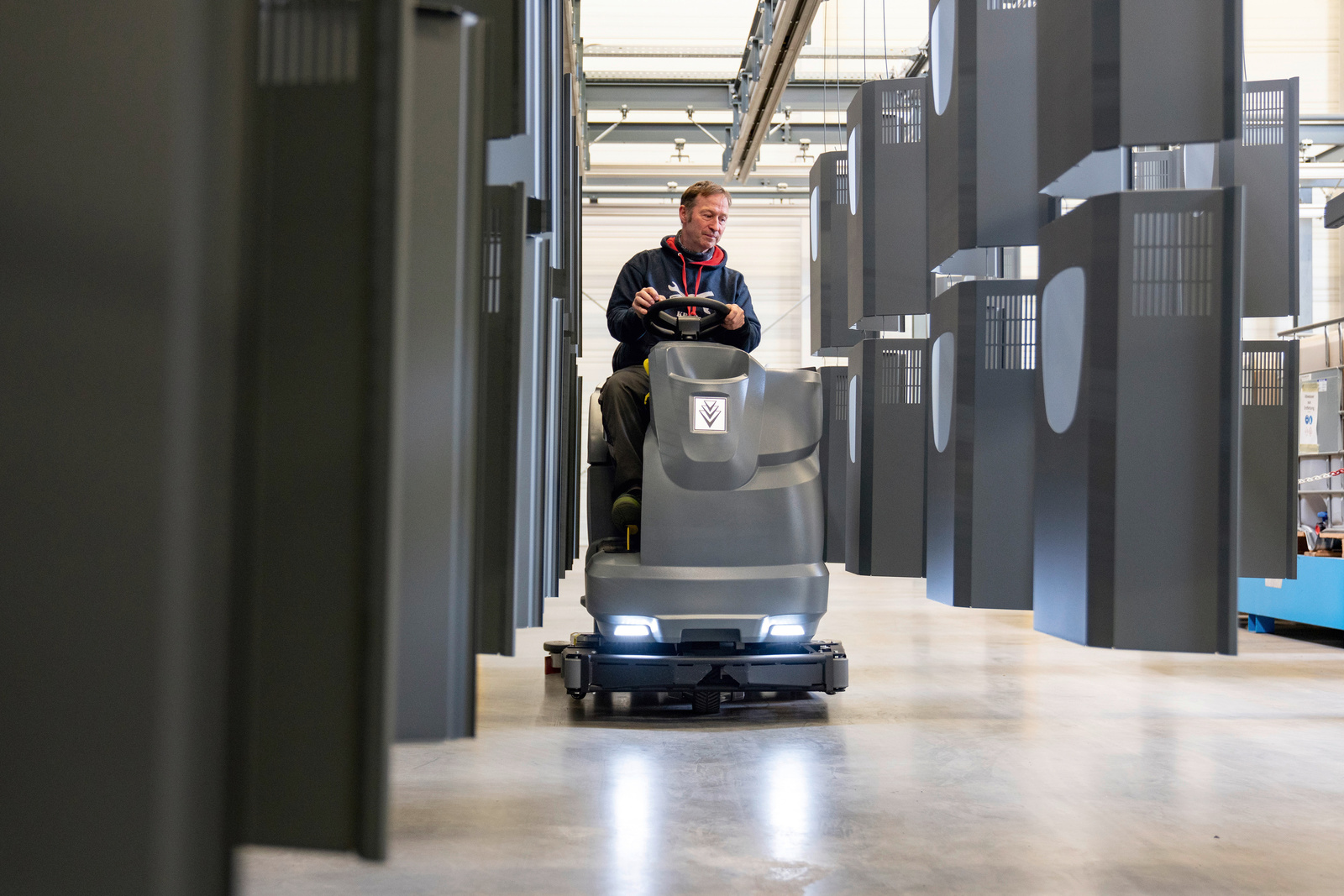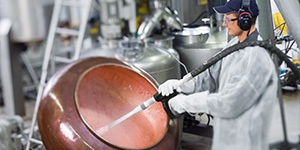PDIR: Four essential cleaning functions
A regular and efficient cleaning routine is hugely important within the Industrial and Transport sector in particular. In fact, it is essential. And that applies to outside and inside areas, including the production, warehouse and loading bay. A well-thought-out concept, a regular schedule and suitable machines and cleaning agents are what's required to get it right. The PDIR cleaning process is a very good place to start.

The PDIR cleaning process
When it comes to keeping production and warehouse clean and ensuring employees safety, prevent production downtime and reduce cost in work force, the four types of cleaning in the PDIR process come highly recommended. The acronym "PDIR" is based on the first letters of the following cleaning functions:

Preventative
Preventative cleaning: Removing dirt in the outside area before it is brought inside the building

Daily
Daily maintenance cleaning: Routine cleaning to maintain the level of cleanliness

Interim
Intermediate cleaning: Cleaning that helps prevent production downtimw and keep time-consuming deep cleaning to a minimum

Restorative
Deep cleaning: Thorough, time-consuming cleaning of floor coverings
Organization is everything
PDIR cleaning really comes into its own when the timings of all four types of cleaning are coordinated as part of a well-organised process. As long as this cleaning system is used regularly, savings can be made on the time, materials and staff resources allocated to daily maintenance, whilst ensuring that the building retains its value and prevent production downtime.
Preventative cleaning: Keeping outside areas spotless
The concept of preventative cleaning tackles dirt head on in the outside areas. Giving the areas outdoors a thorough clean can help reduce the amount of dirt traipsed into a building by as much as two thirds. It's important not to forget the pavement and parts of the road that are close to the entrance area. Not to mention car parks, any other factory or warehouse entrances and the public areas in front of goods entrances, loading bay, etc. And then there are the outside areas belonging to the factory like rubbish dump and canteen, as large amounts of dirt can soon accumulate here too and be brought into the corridors, stairwells, warehouse, production area. Given that there is the option of using (vacuum) sweepers and high-pressure cleaners when required, preventative cleaning requires less time and hard work than is needed to clean warehouse and production areas. Since this type of cleaning tackles the main source of dirt, the outside areas, it does have a huge impact on all of the subsequent cleaning and maintenance measures.

Product recommendation for outdoor cleaning
Daily maintenance cleaning: For hygiene and a squeaky clean image
Daily maintenance cleaning is part of the routine in a factory or warehouse, helping to achieve the desired level of cleanliness and thereby ensuring employees feel happy and at ease, increasing productivity and reduce downtime. It is also a necessity that avoids permanent damage being caused by dirt being left to stick onto surfaces, meaning it lengthens their service life quite considerably.

Product recommendation for Indoor cleaning

Intermediate cleaning: Using the right methods to do away with downtimes
Intermediate cleaning is always required every now and then – even when maintenance cleaning takes place on a daily basis. It helps to cut back on production downtime or production service, which is both time-consuming and thus costly, and also to maintain a high standard of cleanliness and safety.
It is vital to select the right method so as to avoid damage on machine which causing downtimes in production, for example Ice Blaster. In other words, a cleaning method needs to be selected that does not leave behind residues to ensure that the production machine can run smoothly on it again soon after cleaning.
If intermediate cleaning is taken care of every so often, the amount of time and effort spent in machine service will drop massively.
Cleanliness in all areas.
Kärcher Ice Blasters do not use any cleaning agents or chemicals. They are suitable for use in all areas where cleaning with water or sand is legally prohibited. Because the pellets dissolve without residues, no waste water is produced. The dry ice pellets can easily be self-made with the aid of the high-performance Kärcher dry ice pelletiser.

Steel, metal and machine construction
Deep cleaning and maintenance cleaning of production machinery, welding robots, conveyor belts and paint shops is extremely easy with Ice Blasters from Kärcher.

Printing plants
After dry ice blasting, all printing machines and cylinders, tools, etc., look like new.

Timber and electrical industry
Dry ice blasting is also ideal for cleaning woodworking machines, generators, turbines, control cabinets, etc.

Plastic and packaging industry
The dry ice blaster removes silicone and rubber as well as dyes, paints and other dirt from injection moulds and production lines.

Automotive industry, foundries and plastic injection moulding plants
Our dry ice cleaners remove binding and parting agents from all kinds of parts and workpieces. Residues such as silicone, rubber, dyes, paints, parting agents, etc., can easily be removed from injection moulds, tools and entire production lines. Cleans perfectly without leaving residues.

Food, pharmaceutical and cosmetics industry
An ice blaster is ideal for removing coking, burnt-in deposits, encrustations, fat and starch from filling and mixing plants, production lines, handling systems as well as tanks and furnaces.

Paper industry
In the paper industry, glue, lime, dust and cellular materials are deposited in the systems. Machine downtimes and loss of quality are the result. Systems are cleaned faster with dry ice and are soon ready to use again.

Local authorities and municipalities
Graffiti and chewing gum: a problem for many cities and municipalities. This calls for a cleaning method that cleans walls and surfaces thoroughly, yet gently – like ice blasters from Kärcher. They remove dirt without damaging surfaces.
Product recommendation for Indoor cleaning
Deep cleaning: Restoring the original condition
Despite all other cleaning and maintenance efforts, it is not possible to avoid deep cleaning floor coverings. The aim, insofar as is possible, is to restore the flooring to its original condition and degree of slip resistance. Of all four cleaning methods, deep cleaning takes up the most time, materials and staff resources. It can, however, be delayed for quite some time if the daily cleaning routine is carried out regularly and properly.
Deep cleaning: Removing heavy soiling
Deep cleaning uses wet scrubbing to remove oil and grease marks and encrusted dirt. This requires powerful scrubber driers with a roller scrubbing head. If the floor covering allows, cleaning is carried out using the two-step method at full contact pressure with green roller brushes or pads. The procedure should always be performed step by step to avoid the floor getting too wet or the cleaning fleet drying out again quickly.
Step 1: Use a scrubber drier to cover the surface that needs cleaning with cleaning agent and then scrub it two or three times until all the dirt has come loose.
Step 2: Remove the dirty water using the squeegee and the suction device on the machine. Then cover the entire area with clean water again and proceed using the one-step method: Cover with water – scrub – suction.
If protective films need to be removed in addition to oil and grease, we recommend using RM 752 or RM 750, the alkaline all-round deep cleaner. The RM 69 floor deep cleaner could also be used. The cleaning agent is diluted to between 5 and 10% depending on how dirty the surface is.
Please note: Only the one-step method is recommend for deep cleaning of industrial floors that have not been treated or surfaces that are not water-resistant (see screed types), as otherwise the floor will get too wet and consequential damage could occur.
























